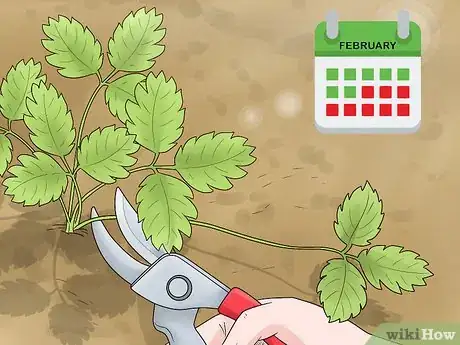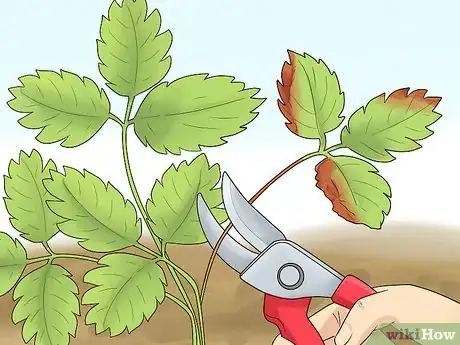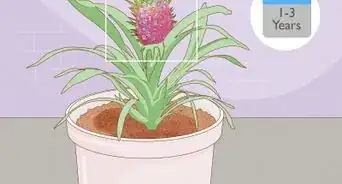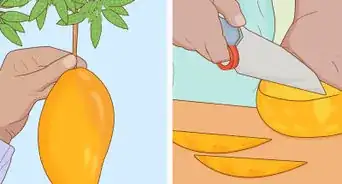This article was co-authored by Maggie Moran. Maggie Moran is a Professional Gardener in Pennsylvania.
wikiHow marks an article as reader-approved once it receives enough positive feedback. In this case, 87% of readers who voted found the article helpful, earning it our reader-approved status.
This article has been viewed 192,509 times.
Pruning your strawberry plants regularly is important to create conditions that encourage sunlight absorption and minimize wasted energy. By following basic pruning practices and learning how to trim your plants, they will be able to thrive and create plenty of delicious strawberries to enjoy with your meals.
Steps
Choosing the Right Time to Prune
-
1Preserve green, healthy leaves throughout the year. Never prune a healthy, green leaf that is still functional. These are the regions of the plant that manufacture fruit, and removing them can decrease your strawberry yields.[1]
- No matter what time of year it is, pruning should be reserved specifically for brown or diseased leaves.
-
2Prune your strawberry plants after mid- to late February. Even pruning your plants lightly before this time can significantly decrease fruit yields. The only thing you should do before this time period is remove dead leaves, and only from plants that were planted late, have grown poorly, or endured a cold winter.[2]
- Never remove healthy and functional leaves, as they are responsible for food production, proper plant growth, and survival.
Advertisement -
3Mow June-bearing strawberries after the last harvest. About 1 week following the last harvest, mow the leaves of your June-bearing strawberries 1 inch (2.5 cm) above the plant crowns. After you're done mowing, do not mow again until next year—anything earlier will destroy newer growth.[3]
- Use a rake to clean up debris after mowing and prevent diseases.
- Avoid mowing late-season strawberries that are harvested in the final week of July.
-
4Cut June-bearing matted rows using a rototiller after harvest. If your June-bearing strawberries are lined in 2 foot (0.61 m) matted rows, use a tiller to narrow them down to strips that are approximately 8 inches (20 cm) wide immediately after harvesting their strawberries. Focus on removing older plants and saving younger ones.[4]
- Space strips about 3 feet (0.91 m) apart.
- Late-season strawberries that are harvested in the last week of July typically don't need to be mowed.
Trimming Your Strawberry Plants
-
1Remove foliage from crops that bear fruit in the summer. Also known as summer bearers, these crops typically flower during the late spring and bear their strawberries in the summer. Snip foliage around 4 inches (10 cm) above their crowns—the aboveground parts that begin at soil level.
- Getting rid of foliage provides room for more newer leaves to kick-start new growth.
-
2Cut old leaves from your plants to get rid of dead weight. Old leaves stop contributing to carbohydrate production, but still absorb water and nutrients. Remove these leaves to help your strawberry plants thrive without putting energy into leaves that aren't giving anything of value back.[5]
- Old leaves can be distinguished by their yellow color, and lose their glossy aesthetic as they age.
- Dead leaves prevent air circulation in the canopy, and also leave your plants more susceptible to disease.
- Long stems are old plants that can be cut at the base with garden shears.[6]
-
3Remove runners to prevent resources from going to clone plants. Most strawberry varieties create runners (also referred to as stolons), which are horizontal connections between the primary strawberry plants that extend over the soil. Trim these connections back to their mother plant. If you don't, they will eventually create their own root system that will ultimately lead to the production of a clone plant.[7]
- Removing runners prevents your plants from wasting the saccharides they generate from photosynthesis—referred to as photoassimilates—on clone plants.
- If growing conditions are optimal (ample sunlight and water access), runners can remain without too much of an impact on your strawberry growth.
- Daughter plants created by runners can be detached from the mother to start new plants after they have rooted. However, this should be done sparingly.
-
4Remove flower stalks from summer-bearing plants. Use your thumb and forefinger to carefully remove flower stalks from plants that bear their strawberries in June. Keep an eye out for them every day, and remove them throughout the first growing season as they appear.[8]
- Take a look at strawberry varieties here: http://www.omafra.gov.on.ca/english/crops/facts/strawvar.htm.
- Be careful not to damage the stalks of your strawberry plants as you remove their flower stalks.
- Only remove the flowers from everbearing plants (which produce fruit all throughout the growing season) and day-neutral plants (which produce flowers regardless of sunlight exposure). In addition, you should only remove flowers up to the middle of June.
-
5Cut flowers when clusters are small or if you need vegetative growth. Flower clusters need to develop a crown at least 0.39 inches (9.9 mm) in diameter with at least 5 or more leaves for successful fruit production. Locate any smaller ones and remove them.
- Remember: the size of your flowers is correlated with the size of your strawberries. You don't want your plants to waste photoassimilates on small flowers, which is why flower removal is necessary.
-
6Remove strawberries to prevent competition between plants. Some people suggest that you keep the number of strawberry fruits low. This is believed to reduce competition between plants and foster larger fruit sizes. But this technique is disputed, and some greenhouses skip it altogether.[9]
- Keep an eye on fruit numbers and average sizes to determine if this technique works for your crop.
-
7Slice off crowns to keep a steady density in highly vegetative plants. Since strawberry plants can create crowns—or extended shoots—from 1 or more auxiliary buds, removing them can effectively promote the development of flower buds.[10]
- Avoid pruning the younger crowns—this can hinder the growth of your plants.
Community Q&A
-
QuestionWhy would I remove flowers? Don't the berries grow from the flower once it is pollinated?
 NinoxTop AnswererYou are right, you mustn't remove all the flowers. Do not remove flowers on varieties that produce fruits only once a year. Remove flowers only before June. Remove small flower clusters. If you do this way, your strawberry plant will produce more fruit and keep its strength.
NinoxTop AnswererYou are right, you mustn't remove all the flowers. Do not remove flowers on varieties that produce fruits only once a year. Remove flowers only before June. Remove small flower clusters. If you do this way, your strawberry plant will produce more fruit and keep its strength. -
QuestionShould I keep strawberry plants watered after the harvest?
 NinoxTop AnswererYes, you should keep the plants watered to help them grow the next year.
NinoxTop AnswererYes, you should keep the plants watered to help them grow the next year. -
QuestionI have leaves growing from the base of my strawberry plant that do not resemble strawberry leaves. Is this common?
 DancingFoxCommunity AnswerThese are likely weeds. Root them up do they don't sap nutrition from your strawberry plant.
DancingFoxCommunity AnswerThese are likely weeds. Root them up do they don't sap nutrition from your strawberry plant.
Things You'll Need
- Gardening gloves
- Garden shears
- Rake
- Mower, tiller, or rototiller
References
- ↑ http://calag.ucanr.edu/archive/?type=pdf&article=ca.v038n05p7
- ↑ http://calag.ucanr.edu/archive/?type=pdf&article=ca.v038n05p7
- ↑ https://www.extension.iastate.edu/news/2008/jul/060101.htm
- ↑ https://www.extension.iastate.edu/news/2008/jul/060101.htm
- ↑ https://cals.arizona.edu/strawberry/Hydroponic_Strawberry_Information_Website/Pruning.html
- ↑ https://youtu.be/ftwpfS5NQQM?t=1m
- ↑ https://cals.arizona.edu/strawberry/Hydroponic_Strawberry_Information_Website/Pruning.html
- ↑ http://www.omafra.gov.on.ca/english/crops/facts/strawvar.htm
- ↑ https://cals.arizona.edu/strawberry/Hydroponic_Strawberry_Information_Website/Pruning.html
About This Article
To prune strawberry plants, use clean gardening shears to remove the runners, which are the small, thin shoots coming off of the main plant. Runners divert energy away from the main plant, so removing them will help keep your strawberry plant healthy and strong. You should also prune off any yellow or dead leaves to help increase air circulation in the canopy. For June-bearing strawberry plants, prune off the flower stalks during the first growing season so the plants get bigger before producing fruit. For day-neutral and ever-bearing plants, remove the flower stalks until the middle of June during the first growing season, then let the plants produce fruit. At the end of the growing season, go over your strawberry plants with a lawnmower to cut them down to about 1 inch (2.5 cm) above the soil, which will help prepare them for next year. For more tips from our Gardening co-author, including how to use a tiller to cut strawberry plants in matted rows, read on!






































































